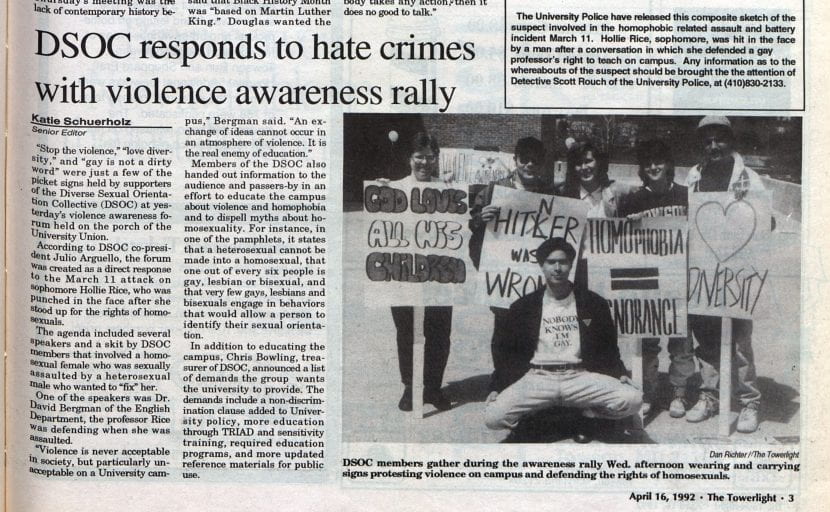In the fall of 2015, I had the privilege of working with students from Professor Oluwatoyin Oduntan’s History 300 class. They came to the archives to learn how to use primary sources and include them in their research. At the end of the semester, I was invited to watch them present their work.
Maria Zlotescu delved into the history of lesbian, gay, bisexual, and transgender people on campus. Besides exploring our student newspaper collection, she conducted interviews with various members of the faculty and staff. She wrote not only about how campuses have become more accepting of LGBTQIA students and staff, but also talked about the general history of gay rights in America.
At the end of class, I asked Ms. Zlotescu if she’d be willing to share her paper with me and perhaps collaborate on a blog post together, as I’d been meaning to write about the Towson University LGBTQIA community for years. She was gracious enough to send her work on, and I’ve shared part of it in this post. Anything written by me is italicized, otherwise it is all Ms. Zlotescu’s words and work.
I feel immense gratitude both to Ms. Zlotescu for being so willing to share her work with us, and also to Professor Oduntan for bringing his class to the archives. This kind of partnership with faculty and students really makes what we do in TU’s Special Collections and Archives meaningful.
In the 1950s and 60s, gay rights activists began to more overtly demand an end to police brutality and a better representation across all facets of society. Gay liberation demonstrations were held in Greenwich Village and San Francisco, and LGBTQIA counterculture groups often modeled themselves after organizations like the Black Panthers or anti-war protesters.
In 1967, two years before Stonewall, Columbia University became the first college in the country to have a gay student group on campus. In the following years several other colleges followed suit, and their involvement with other causes such as the Vietnam War protests helped integrate the gay community into college life. In the next decade Towson would join their ranks.
The next year, an article in an issue of the Towson State College Towerlight spoke out about the cultural view of homosexuality, but in terms that were still very laden in the vernacular of intolerant society. The headline trumpeted about “sexual deviancy” and the author, while asserting that those who identified as gay or lesbian were not immoral, still maintained that they were “unnatural”.
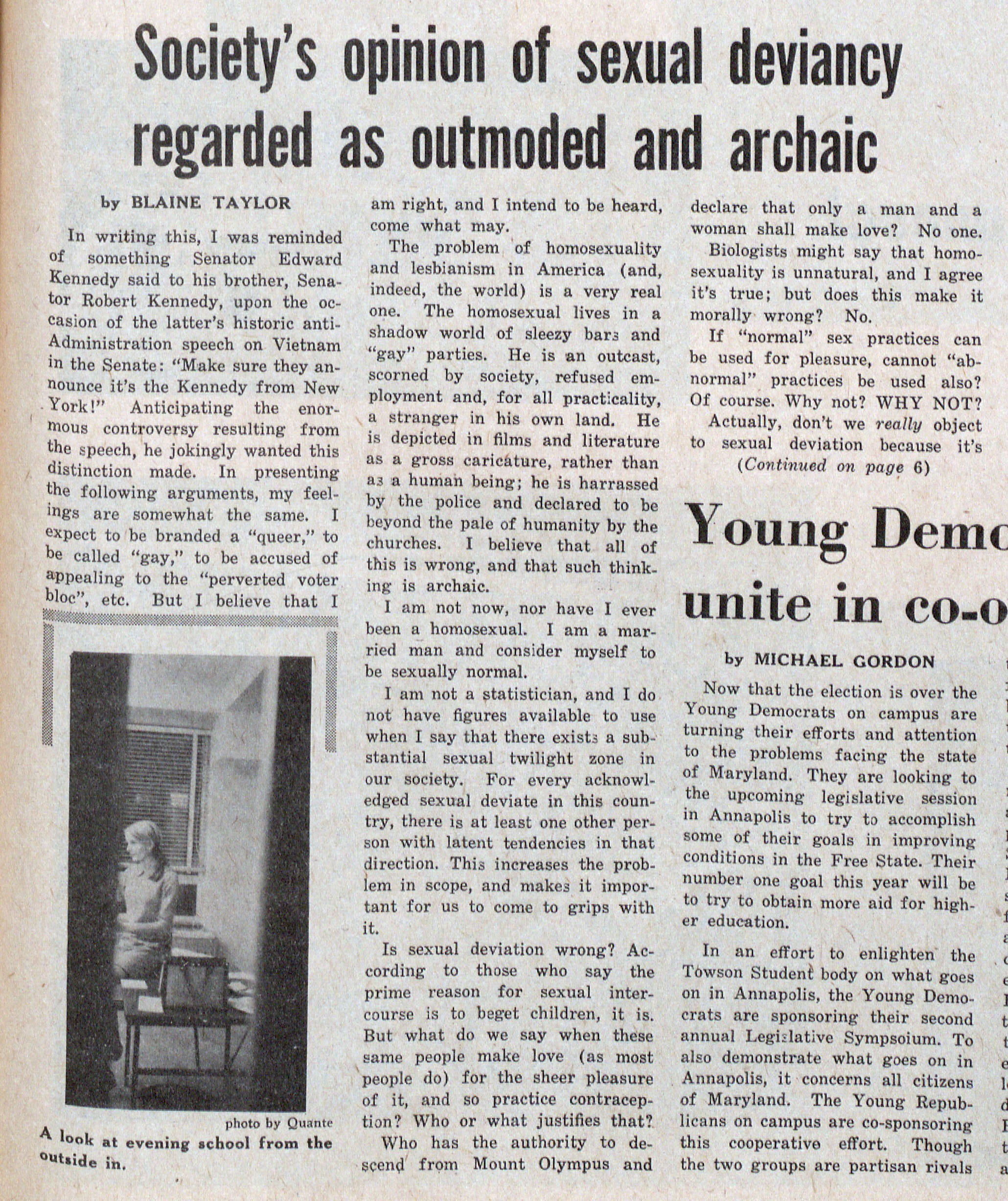
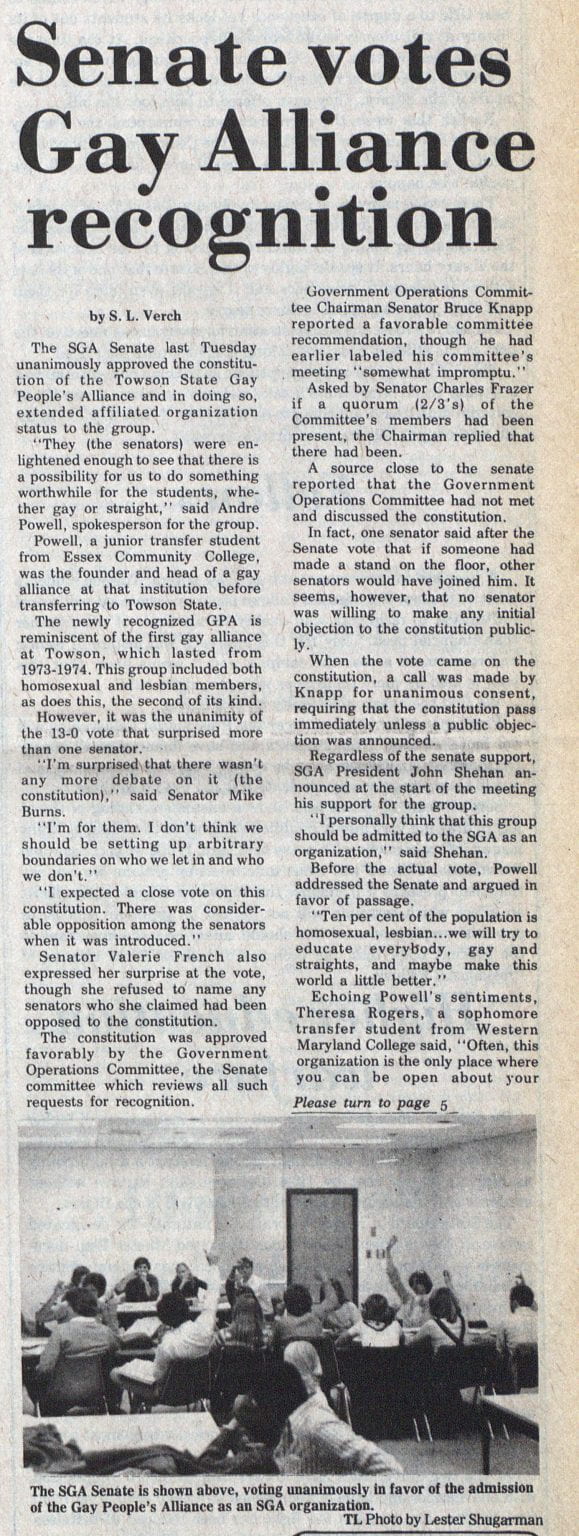
The Start of Student Groups: The 70’s
n 1973, Towson had its first gay support group, the Gay Alliance. It was unrecognized by the school. Perhaps because of that – and lack of student interest – the club only lasted one year.Later in 1978 students decided to restart the Gay Alliance, this time applying for recognition by the school. The SGA voted to grant them official club status in a unanimous vote. While this vote may seem unremarkable today, in the 1970’s most universities in America had no gay rights groups to speak of.
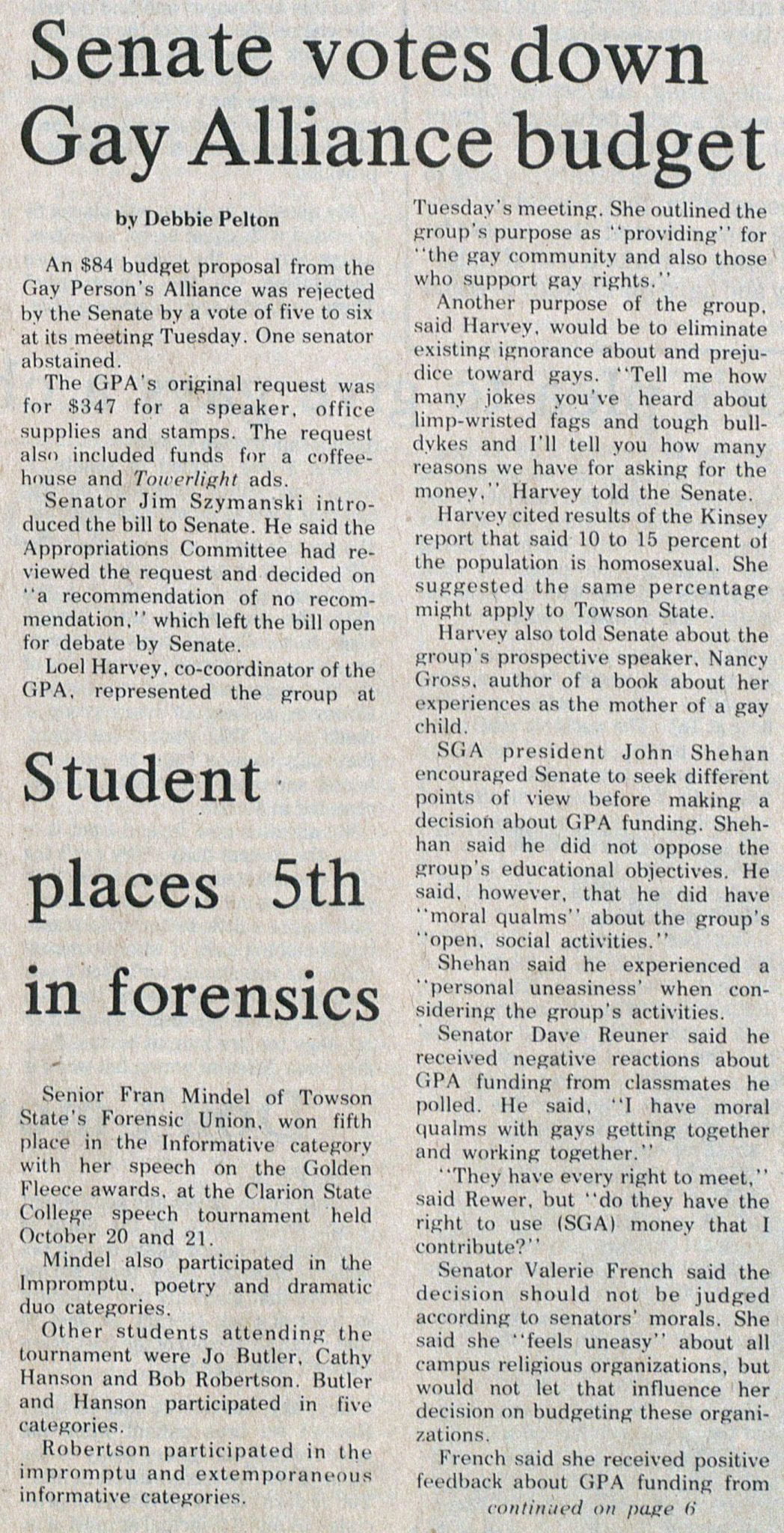
Not only was there backlash from students, in the next school year four new members joined the SGA, some of whom were not tolerant to say the least.
Therefore it is not surprising when the Gay Alliance’s proposed budget of $84 was rejected in the fall of 1978. This would amount to $317.62 in 2015. The club fell apart soon after.
Towson During The Reagan Administration: the 80’s
And yet the Campus ministry at Towson made a decision to reach out to gay and lesbian students. This led to the creation of the Gay and Lesbian Outreach, or GALO, in 1986. It was formed to replace the Gay Alliance. The group met in the Health Center, although it was started in off campus Catholic center called the Newman Center.
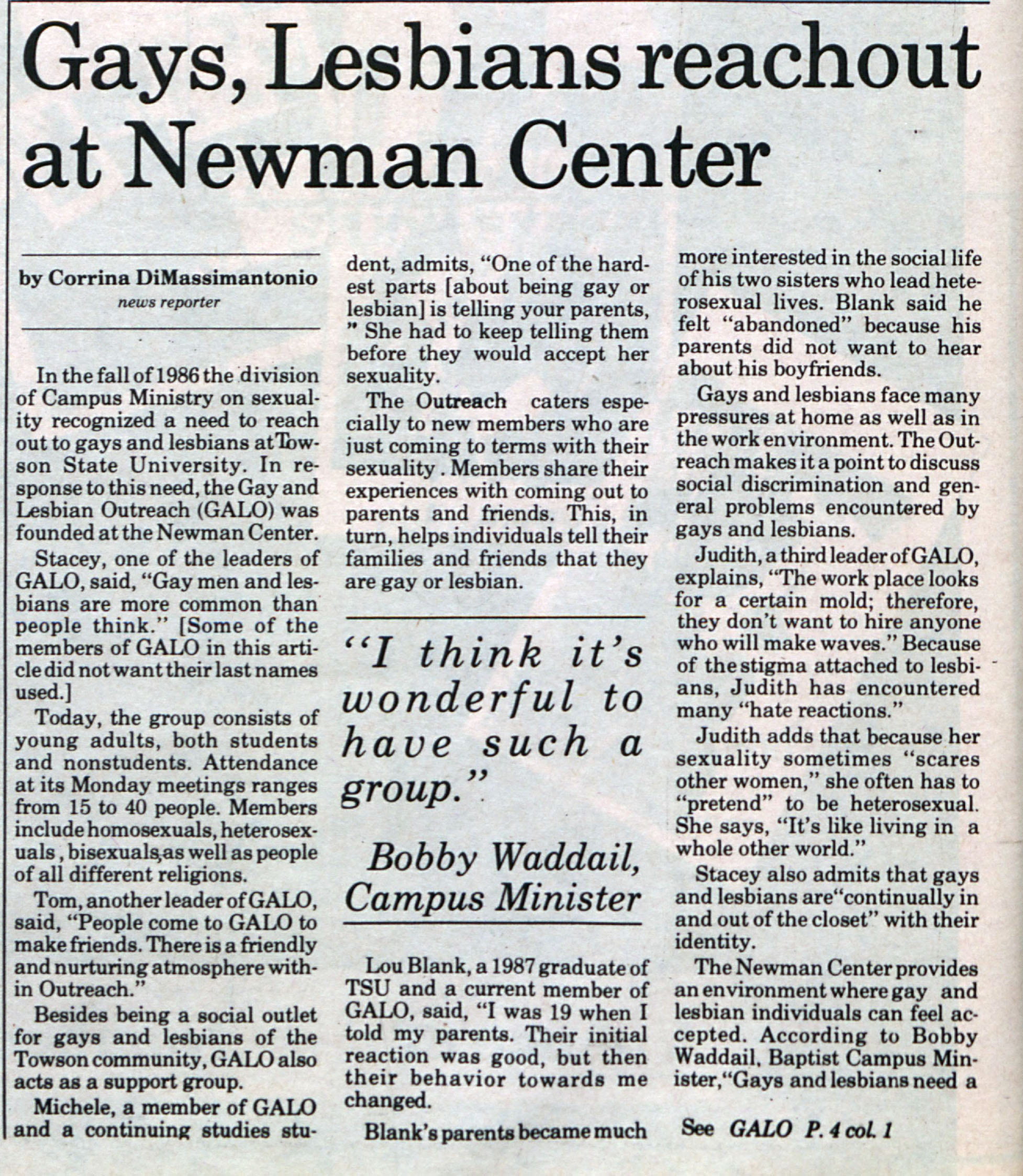
GALO mainly focused on social support for LGBT students and did not participate in political activity. For several years they did not apply for SGA affiliation, possibly because the SGA had refused to give their predecessor funding. The group ranged from 15 to 40 members. It mainly focused on social support about coming out and harassment as opposed to political issues.
Despite the emphasis on sexual diversity, GALO and the later Diverse Sexual Orientation Coalition was mostly made up of white students until the 2000’s. This mirrored a tendency in America to ignore LGBT people of color, a trend which still continues in many aspects of the LGBT community to this day.
Towson created the Task Force on Gay and Lesbian Issues in 1988. Unfortunately there was not any space at the time for a Gay and Lesbian Center until the 1990’s. This task force dealt with instances of homophobia and hate crimes on campus. The Task Force was later converted to the Towson Committee for LGBT issues.
DSOC and Activism
The Diverse Sexual Orientation Coalition was founded in 1990 as an offshoot of GALO. Unlike GALO, DSOC was based on campus and comprised solely of Towson students. They applied for and received SGA affiliation the next year without incident. DSOC also had a more political agenda. This was demonstrated in their quick and active responses to various events on campus.
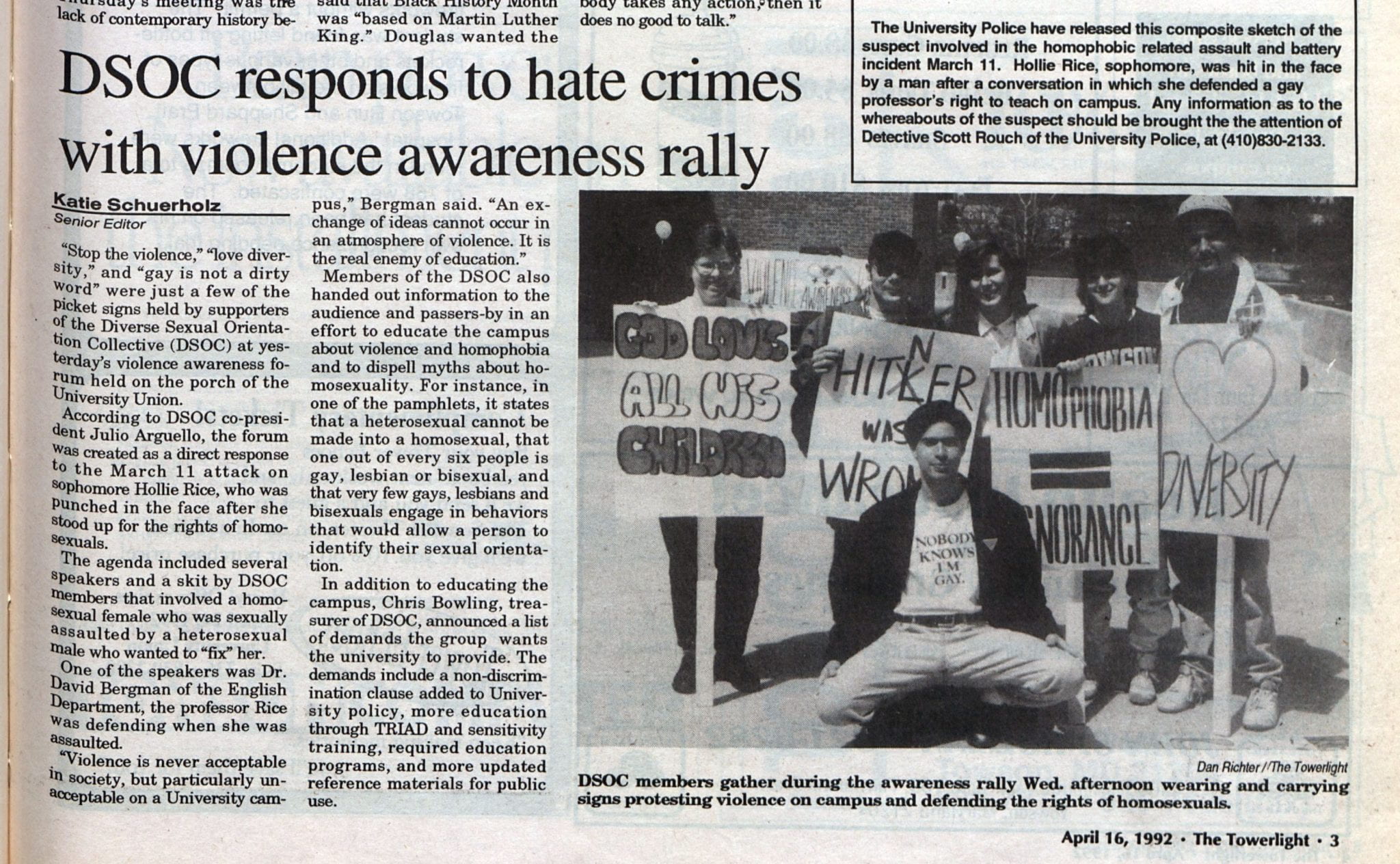
In the early 2000’s the DSOC coordinators requested an official LGBT center. They cited statistics demonstrating that LGBT students are at a greater risk of dropping out, failing, substance abuse and suicide. In response the Office for Services in Student Diversity opened a center for LGBT students in 2004, complete with a full time director to address the needs of the LGBT student population. Before this the committee and the DSOC shared a room in the Psychology building. The director replaced the old committee on LGBT issues.
Name Change Controversy
In 2004, members of DSOC decided that their name should be changed to reflect a more inclusive environment for transgender and gender non binary students. They researched names of other groups in the country and eventually voted for the Queer Student Union. Although the word queer had been used as an insult towards the LGBT community in the past, there was a trend that started in the early 2000’s to take back the word. The students argued that reclaiming an insult and using it to describe themselves causes the word to lose its hurtful power. . . .
And yet this proposed name was met with controversy. Members of the SGA thought a word with a traditionally derogative name like “queer” would turn away prospective students, no matter what the intention of the name was. Some people — including the SGA senator responsible for representing the group — even campaigned against it, going around campus asking students to sign petitions. Then there were people who thought the name was insulting to LGBT people and disagreed with the club’s philosophy behind the name change. And of course there was garden variety homophobia; people who did not care about the name per say so much as the actual club itself. DSOC had to testify in front of the SGA in order to be allowed to change their name. In a surprising turn of events, cultural groups like the Black Student Union and the Latino American Student Organization showed up in the DSOC’s defense. They argued that they would not want the SGA telling them what to name themselves, and that the DSOC should get the same consideration. . . .

DSOC won their case and their name change. The name Queer Student Union remains to this day.
Current Membership
Earlier LGBT groups at Towson were comprised of mostly white students. It was not until the last decade that the group has gotten more diverse, both in terms of membership and officers. In addition to the QSU, students have recently started In the Life, a group specifically for LGBT students of color. Membership overall has also gone up. The QSU now has upwards of 80 members, one of the biggest clubs on campus.
Another recent group is the Pride Mentorship Program. Students sign up and are paired with a queer mentor who acts as a guide for LGBT related issues as well as college life in general.
While in the past Towson’s LGBT community had gathered together around political rallies and educational seminars, recent planned events have a more social purpose. For example, in 2005 Towson started hosting a drag show every semester. Students would perform songs and dances will in costume along with local celebrities such as the winner of Miss Gay Baltimore and performers all the way from Boston. There are also events such as drag queen bingo, holiday themed events such as “Halloqueer” and a queer prom.
Towson also hosts the LGBT Youth Summit in the fall. High school gay-straight alliances from around the area come to an all-day conference with seminars about sexuality and relationship as well as a dance. QSU members volunteer to help run sessions and guide people around campus. The event is run by the Gay Lesbian and Straight Education Network (GLSEN). . . .
Since the dawn of dormitories, college has been about education, self-discovery and growth. Sometimes that applies to the students, and sometimes that applies to the institution itself.
